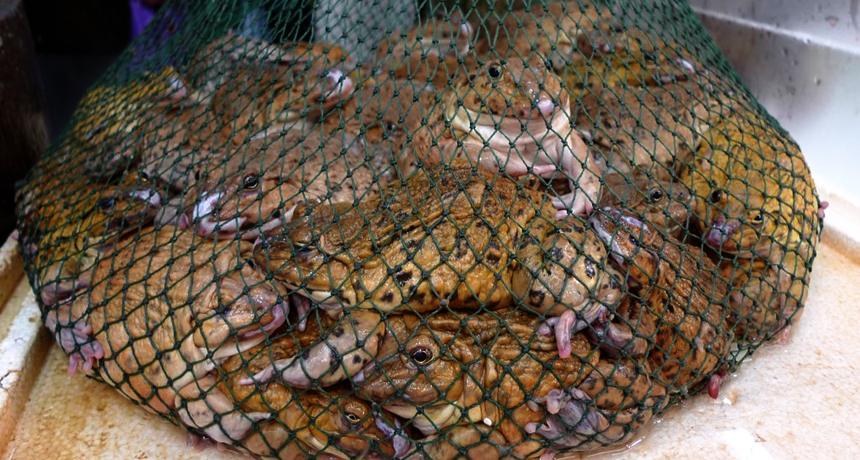Amphibian diseases flow through animal trade

Millions of amphibians are sold in Hong Kong and exported, including to the United States. Diseased animals may be spreading diseases such as the chytrid fungus, say scientists.
annavolcana/Flickr (CC BY-NC-SA 2.0)
- More than 2 years ago
Disease isn’t the biggest killer of amphibians — that would be habitat loss — but it can be the quickest. And the chytrid fungus (Batrachochytrium dendrobatidis) in particular has been a huge worry for scientists and anyone else who cares about the world’s frogs, toads, salamanders and newts. The disease spreads through water and skin contact (mating, for instance, can be dangerous), infecting the skin of the animal and disrupting its ability to absorb water. Amphibians rely on that water absorption to control electrolyte levels; when that’s disrupted, it usually leads to death. Some 3,900 species are thought to be in trouble because of the disease, and 165 have probably gone extinct.
If that weren’t enough, ranaviruses have also been associated with dieoffs of many amphibian species. These viruses spread through a variety of routes, including cannibalism. With symptoms ranging from lethargy to organ failure, detecting the disease is rarely straightforward.
Just how these diseases move around the world isn’t always certain, but the global trade in amphibians is probably contributing.
The amphibian trade is far bigger than the movement of a few frogs and toads through pet stores. More than 100 million amphibians are harvested from the wild each year, and millions more are raised to be sold for meat, pets, scientific research and even for religious ceremonies. That’s a lot of frogs moving around the world.
Hong Kong is a global hub for this trade; the United States, for example, imported 3.6 million live amphibians from Hong Kong from 2006 through 2010. But many of those animals may carry disease, Jonathan Kolby of James Cook University in Australia and colleagues report March 5 in PLOS ONE.
The researchers randomly sampled amphibian shipments from Hong Kong when they arrived in the United States, swabbing amphibians in the shipments and taking samples of the water in which they arrived and testing the swabs and water for DNA of the chytrid fungus and ranavirus. They found the chytrid fungus in 11.7 percent of amphibians tested and five of eight water samples examined (most amphibians are shipped in water). And they discovered ranavirus in 56.8 percent of animals and three out of four shipments.
Shippers may not be deliberately trading in diseased animals. Often when amphibians are infected with the chytrid fungus or ranavirus, they don’t show any symptoms, such as lesions, which can make identifying sick animals difficult. In the study, only 21.3 percent of the animals that tested positive for chytrid or ranavirus arrived dead or had visible lesions.
When the animals arrive in the United States, they can spread the pathogens both through the water they arrived in and the accidental or deliberate release of the amphibians into the wild. The traditional Buddhist practice of releasing animals as a symbol of piety, for example, is thought to be contributing to the spread of the chytrid disease.
And the sanitation practices of the traders probably aren’t helping matters. The World Organization for Animal Health suggests that any water, containers or anything else that comes in contact with amphibians be cleaned and disinfected before disposal. But those recommendations aren’t enforced in Hong Kong. That puts local wildlife at risk, say Kolby and colleagues. If a trader just dumps out a tank of frog water, he might be letting lose a dangerous fungus or virus, which can persist for weeks and potentially infect native amphibians.
With these pathogens continuing to spread, it would appear that the wildlife trade needs some attention.
Amphibian owners can also do their part by quarantining new animals, practicing good hygiene and keeping their animals from escaping to the wild and potentially spreading disease.






